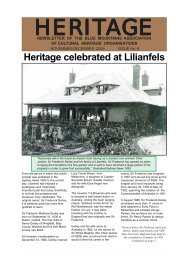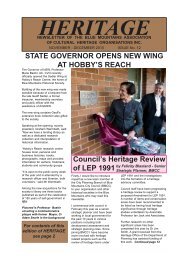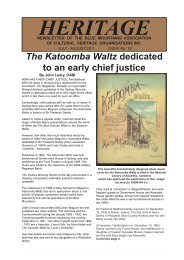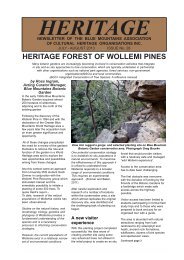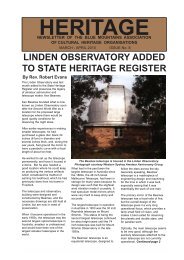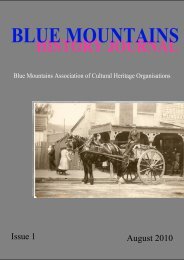Newsletter No. 15 - Blue Mountains Association of Cultural Heritage ...
Newsletter No. 15 - Blue Mountains Association of Cultural Heritage ...
Newsletter No. 15 - Blue Mountains Association of Cultural Heritage ...
You also want an ePaper? Increase the reach of your titles
YUMPU automatically turns print PDFs into web optimized ePapers that Google loves.
Children “in a desperate state <strong>of</strong> ignorance”<br />
Continued from page 11<br />
Another, only recently demolished,<br />
operated from a cottage behind<br />
‘Bonnie Blink’, the stately 1870s’<br />
home in Bonnie Blink Drive.<br />
The impetus for an extension <strong>of</strong><br />
educational facilities was afforded<br />
by the passage <strong>of</strong> the Public<br />
Schools Act, 1866 whereby the<br />
Council <strong>of</strong> Education could take<br />
over all types <strong>of</strong> public schools and<br />
grant aid to certified denominational<br />
schools.<br />
If the school complied, the Council<br />
<strong>of</strong> Education paid the teacher’s<br />
salary and supplied ‘school<br />
materials’, <strong>of</strong>ten helping with<br />
building maintenance.<br />
The discovery <strong>of</strong> gold in the<br />
Bathurst area the previous decade<br />
had resulted in a booming Hartley<br />
economy - the inns were always full<br />
with a constant flow <strong>of</strong> travellers<br />
intent on making their fortunes<br />
affording many opportunities for<br />
skilled and semi-skilled labour.<br />
On June 24, 1868 a number <strong>of</strong> local<br />
Hartley residents applied to the<br />
Education Council to change their<br />
present Anglican denominational<br />
school into a provisional one.<br />
However, the regional inspector<br />
decided that a provisional school<br />
was not warranted and that Hartley<br />
should become a half-time school in<br />
tandem with the Dudawarra School<br />
8 miles away.<br />
In a half-time school the teacher<br />
alternated between two schools,<br />
sometimes on a daily basis; or<br />
teaching at one school in the<br />
morning and the other in the<br />
afternoon. This suggestion received<br />
support from the Council <strong>of</strong><br />
Education and the necessary<br />
arrangements were put in place.<br />
Mr H Blyth, then the teacher <strong>of</strong><br />
Eurobodalla School, arrived in<br />
Hartley to teach in the now public<br />
schools, each morning at Hartley<br />
and each afternoon at Dudawarra,<br />
even though it involved a daily<br />
horse ride <strong>of</strong> 16 miles.<br />
Blyth considered this necessary,<br />
A view <strong>of</strong> the Hartley Public School. Holterman Collection c.1871-75.<br />
Source: ML Home & Away Videolink Still 38736.<br />
fearing that if he left his pupils for a<br />
full day, they would very likely go to<br />
the Catholic school, substantially<br />
reducing his salary which was paid<br />
by a £60 contribution from the<br />
Council <strong>of</strong> Eucation and from fees<br />
paid by the children.<br />
There were 21 children at Hartley<br />
(some were 18 years old!) with 27<br />
children at Dudawarra. Blyth<br />
commented that they were ‘in a<br />
desperate state <strong>of</strong> ignorance’, a<br />
situation he hoped to improve with<br />
the aid <strong>of</strong> a blackboard and easel.<br />
This basic request was however<br />
initially refused as ‘not really<br />
necessary’ by William Wilkins,<br />
secretary <strong>of</strong> the Council <strong>of</strong><br />
Education and hailed as one <strong>of</strong> the<br />
foremost colonial educators <strong>of</strong> the<br />
19 th century, but he finally acceded<br />
to the request with the intervention<br />
<strong>of</strong> the local inspector.<br />
The poor standard or indeed the<br />
total lack <strong>of</strong> education in outlying<br />
areas <strong>of</strong> rural districts was a<br />
constant observation <strong>of</strong> educators<br />
for the last half <strong>of</strong> the nineteenth<br />
century and much <strong>of</strong> the early<br />
twentieth century.<br />
This was not always helped by<br />
some poorly trained or inadequate<br />
teachers.<br />
However within a year <strong>of</strong> his<br />
appointment, Mr Blyth left the<br />
district - and his replacement’s<br />
tenure was equally short.<br />
The Hartley district however<br />
continued to grow - the railway<br />
linking Sydney with Bathurst had<br />
reached Mt Victoria by 1868 and<br />
began the torturous descent into<br />
Lithgow, via the Darling Causeway,<br />
Bell and the Zig Zag, opening in<br />
1869.<br />
The rail link allowed exploitation <strong>of</strong><br />
the coal deposits <strong>of</strong> Lithgow Valley<br />
and Wallerawang and the<br />
development <strong>of</strong> Lithgow’s<br />
secondary industries and the<br />
central western pastoral industry.<br />
For the Hartley Valley it was vital in<br />
the development <strong>of</strong> the oil-shale<br />
mining and retorting industries<br />
which began in Hartley Vale in the<br />
second half <strong>of</strong> 1865, utilising the rail<br />
line via a steep incline up an almost<br />
vertical face from the floor <strong>of</strong><br />
Hartley Valley to the Sydney rail link<br />
on the Darling Causeway.<br />
With the rapid growth in the<br />
population <strong>of</strong> Hartley Valley, the Rev<br />
Mayne approached the Council <strong>of</strong><br />
Education for assistance in<br />
removing the school into more<br />
appropriate accommodation.<br />
Two acres for a school site had<br />
already been donated in the Hartley<br />
Village and Rev Mayne had<br />
arranged for the purchase <strong>of</strong> a<br />
building formerly used by the<br />
fettlers working on the Great<br />
Western Line extension at One Tree<br />
Hill (later Mt Victoria) as a school<br />
for their children.<br />
Continued page 13<br />
HERITAGE 12<br />
May - June 2011




